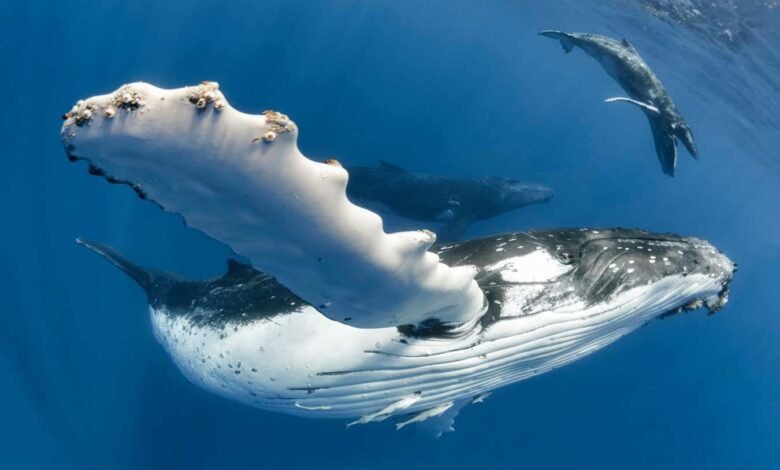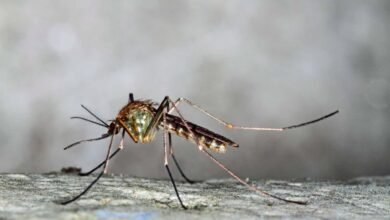Humpback whale songs have patterns that resemble human language


Humpback whales in the South Pacific
Tony Wu/Nature Picture Library/Alamy
Humpback whale songs have statistical patterns in their structure that are remarkably similar to those seen in human language. While this doesn’t mean the songs convey complex meanings like our sentences do, it hints that whales may learn their songs in a similar way to how human infants start to understand language.
Only male humpback whales (Megaptera novaeangliae) sing, and the behaviour is thought to be important for attracting mates. The songs are constantly evolving, with new elements appearing and spreading through the population until the old song is completely replaced with a new one.
“We think it’s a little bit like a standardised test, where everybody’s got to do the same task but you can make changes and embellishments to show that you’re better at the task than everybody else,” says Jenny Allen at Griffith University in Gold Coast, Australia.
Instead of trying to find meaning in the songs, Allen and her colleagues were looking for innate structural patterns that may be similar to those seen in human language. They analysed eight years of whale songs recorded around New Caledonia in the Pacific Ocean.
The researchers started by by creating alphanumeric codes to represent every song from every recording, including around 150 unique sounds in total. “Basically it’s a different grouping of sounds, so one year they might do grunt grunt squeak, and so we’ll have AAB, and then another year they might have moan squeak grunt, and so that would be CBA,” says Allen.
Once all the songs had been encoded, a team of linguists had to figure out how best to analyse so much data. The breakthrough came when the researchers decided to use an analysis technique that applies to how infants discover words, called transitional probability.
“Speech is continuous and there are no pauses between words, so infants have to discover word boundaries,” says Inbal Arnon at the Hebrew University of Jerusalem. “To do this, they use low-level statistical information: specifically, sounds are more likely to occur together if they are part of the same word. Infants use these dips in the probability that one sound follows another to discover word boundaries.”
For example, in the phrase “pretty flowers”, a child intuitively recognises that the syllables “pre” and “tty” are more likely to go together than “tty” and “flow”. “If whale song has a similar statistical structure, these cues should be useful for segmenting it as well,” says Arnon.
Using the alphanumeric versions of the whale songs, the team calculated the transitional probabilities between consecutive sound elements, making a cut when the next sound element was surprising given the previous one.
“Those cuts divide the song into segmented sub-sequences,” says Arnon. “We then looked at their distribution and found, amazingly, that they follow the same distribution found across all human languages.”
In this pattern, called a Zipfian distribution, the prevalence of less common words drops off in a predictable way. The other striking discovery is that the most common whale sounds tend to be short, just as the most common human words are – a rule known Zipf’s law of abbreviation.
Nick Enfield at the University of Sydney, who wasn’t involved in the study, says it is a novel way of analysing whale song. “What it means is that if you analyse War and Peace, the most frequent word will be twice as frequent as the next and so on – and the researchers have identified a similar pattern in whale songs,” he says.
Team member Simon Kirby at the University of Edinburgh, UK, says he didn’t think the method would work. “I’ll never forget the moment that graph appeared, looking just like the one we know so well from human language,” he says. “This made us realise that we’d uncovered a deep commonality between these two species, separated by tens of millions of years of evolution.”
However, the researchers emphasise that this statistical pattern doesn’t lead to the conclusion that whale song is a language that conveys meaning as we would understand it. They suggest that a possible reason for the commonality is that both whale song and human language are learned culturally.
“The physical distribution of words or sounds in language is a really fascinating feature, but there’s a million other things about language that are just entirely different from whale song,” says Enfield.
In a separate study published this week, Mason Youngblood at Stony Brook University in New York found that other marine mammals may also have structural similarities to human language in their communication.
Menzerath’s law, which predicts that sentences with more words should be composed of shorter words, was present in 11 out of 16 cetacean species studied. Zipf’s law of abbreviation was found in two out of five species where available data made it possible to detect.
“Taken together, our studies suggest that humpback whale song has evolved to be more efficient and easier to learn, and that these features can be found at the level of notes within phrases, and phrases within songs,” says Youngblood.
“Importantly, the evolution of these songs is both biological and cultural. Some features, like Menzerath’s law, may emerge through the biological evolution of the vocal apparatus, whereas other features, like Zipf’s rank-frequency law [the Zipfian distribution], may require the cultural transmission of songs between individuals,” he says.
Topics:
Source link




